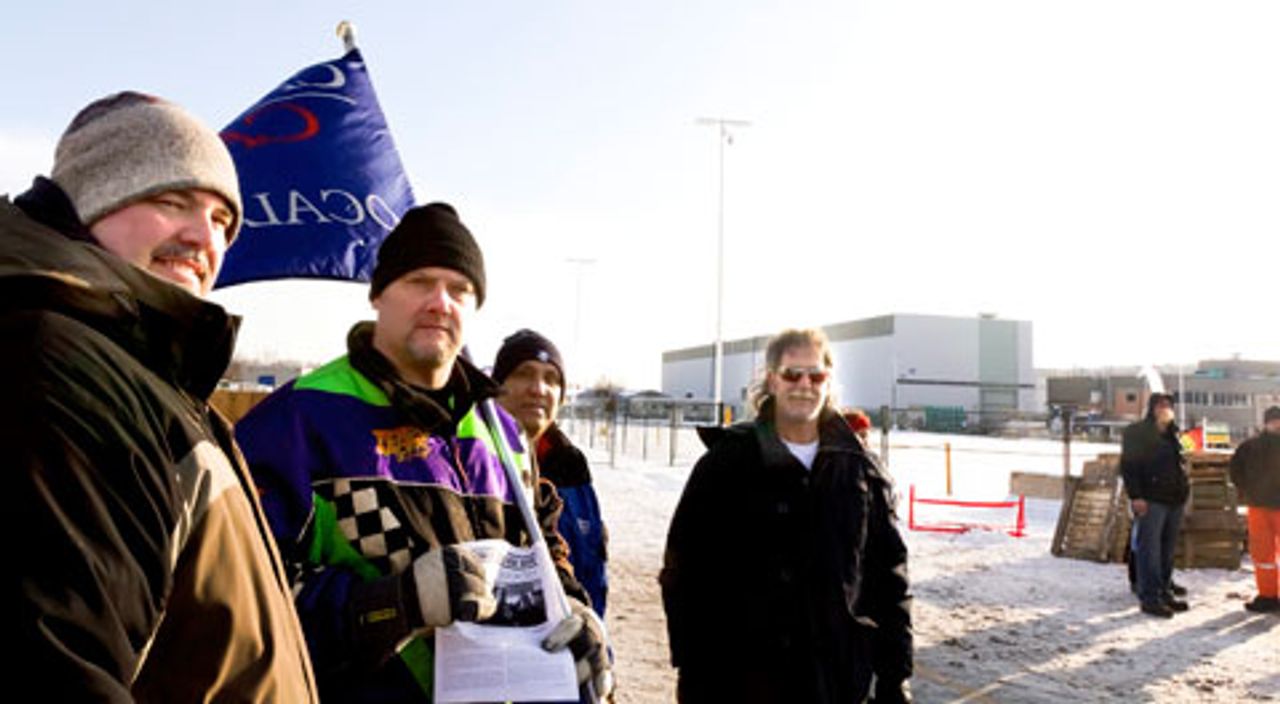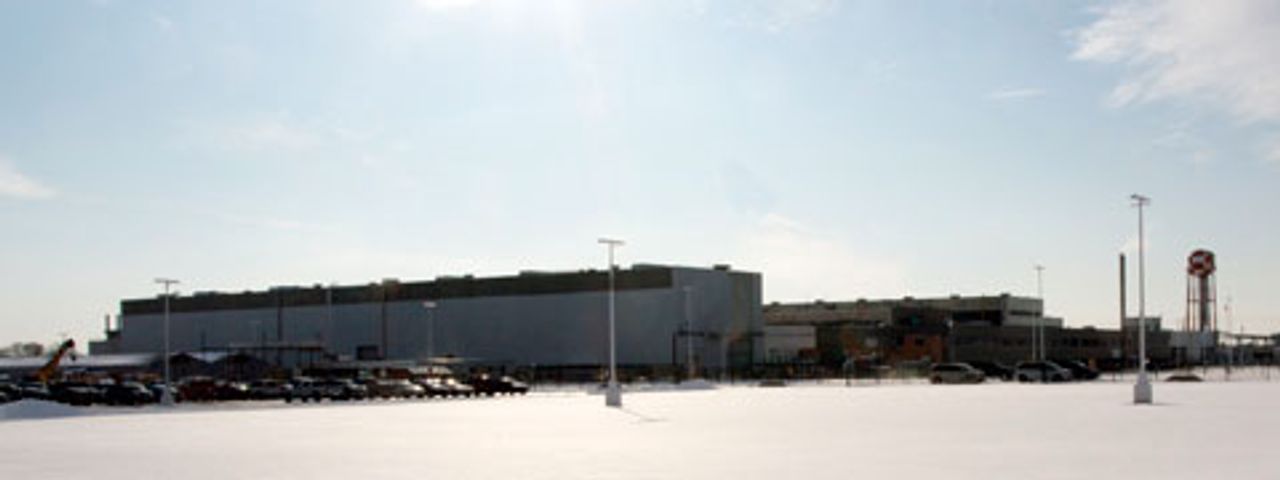 Left to right: Sean, Dave, and Rafeek
Left to right: Sean, Dave, and RafeekSince Caterpillar locked out 425 employees at its Electro-Motive Diesel locomotive assembly facility in London, Ontario on Sunday night, the workers have manned daily picket lines at the factory gate, determined to resist the company’s drive to cut their wages by more than half. They are outraged at the company’s demands, as a number of them explained to WSWS reporters on Wednesday.
“The whole world is watching us. If we fold, every other locomotive factory will cut wages,” said one worker with six years at the plant, located east of downtown London in a heavily industrial area. Truck drivers and motorists honked their car horns in support as they drove by the facility on Oxford Street East.
Caterpillar, which bought the factory in 2010 through its Progress Rail division, locked out the workers after they voted by 98 percent to reject a contract that would cut their wages to $16.50 from $35 per hour.
“They want half our wages, they want us to have no pensions, and we’ll have to pay 25 percent of our medical expenses. We’ll be losing $35,000 a year, right off the top,” said Mike Fleming, a locomotive assembly worker.
“In Canada, you can’t live on that. I couldn’t afford to drive to work every day on what they want to pay me,” said Fleming. While the US and Canadian dollars are more or less at par at present, the cost of gas, groceries, and housing is higher in Canada than in the United States.
 Mike Fleming has worked at the plant for over 23 years
Mike Fleming has worked at the plant for over 23 yearsThe workers noted that GE Transportation Systems, the main competitor of Electro-Motive, recently signed a contract paying its locomotive workers over $30 per hour. “It’s starting with us; if they see that Caterpillar can do this to us, then they can do it to everybody,” added Fleming.
The attack on Ontario workers follows the ongoing lockout of over a thousand workers at Cooper Tire in Findlay, Ohio, which began November 28, and came the same day as a lockout of 755 Rio Tinto Alcan smelter workers in Alma, Quebec.
The London plant is the final assembly point for nearly all Electro-Motive Diesel locomotives. In October 2011, the company opened up a production facility in Muncie, Indiana, paying workers $12 per hour—one-third the wage of the Ontario workers—but production there is proceeding at a snail’s pace, according to the London workers. One told the WSWS that 60 workers had quit the Muncie plant last week, taking their tools with them. “They can’t keep people at that pay,” he said.
Electro-Motive operates an engineering facility and parts plant in La Grange, Illinois, a suburb of Chicago, which makes the diesel engines and generators that are assembled in the Ontario plant. Workers at the Illinois plant are members of the United Auto Workers and are currently working without a contract. After acquiring Electro-Motive in 2010, Caterpillar also opened a facility to rebuild traction motors and other electrical equipment in San Luis Potosi, Mexico.
Almost all modern diesel-powered locomotives use the diesel-electric design, which uses a large diesel engine to turn a generator that in turn powers electric motors for propulsion.
 The plant
The plantBuilding the locomotives is a highly skilled and intricate process, requiring nearly three months for a single locomotive. “You couldn’t bring an employment agency in and have them do our jobs. The skills that we have are all handed down from the workers before us,” said Mike Fleming. “Everybody who went through this plant has a trade,” added Sean.
Assembly is often not a matter of bolting together pre-made parts; rather assembly workers are responsible for the final functionality of each part, often each valued in the hundreds of thousands of dollars. “That’s where the skill-set comes in. If a part isn’t right, it’s our job to fix it and to make it work,” said Rafeek Khan, a worker originally from Guyana.
The workers speak about the locomotives they make with great pride, and of the string of corporations that have snatched up their shop over the years with derision, not only for the attacks they have suffered, but for the fact that the various company managements have no concern for the quality of the product.
“The attrition and speedups have really impacted what comes out of here,” said another worker. “I wish I could say we make a better locomotive now than we did 20 years ago. But that’s just not the case.”
The locomotives are sold all over the world, but the main customers are major railroads in the US, including Union Pacific and Burlington Northern, workers said. “We’ve sold all over the world: Egypt, Saudi Arabia, Taiwan, South Africa, Indonesia, Europe,” said Mike Fleming, proudly.
Locomotives typically stay in service for decades, and are periodically remanufactured when parts wear out. Electro-Motive locomotives are known for their longevity, and it is not unusual to find them in operation after 50 or 60 years. “As far as quality and durability, you can’t touch our locomotives,” said Sean.
Electro-Motive used to control over 60 percent of the market for diesel locomotives, but has lost ground over the past several decades to General Electric, which opened up a much larger plant in Erie, Pennsylvania in the 1990s and has been gaining market share since. In 2010, Electro-Motive received some 30 percent of new orders for diesel locomotives, with General Electric producing the remaining 70 percent.
Electro-Motive Diesel was founded in 1922 and bought by General Motors in 1930, which held it as a subsidiary for most of its existence. In 2005, General Motors sold off Electro-Motive to Greenbriar Equity Group and Berkshire Partners for $201 million.
“I haven’t had a raise in six years. They took away all our vacations, all our Christmas bonuses. The buyout companies and now Caterpillar have done nothing but take away from us,” said Mike.
In 2010, Greenbriar and Berkshire sold the company to Caterpillar for $820 million. “We’d been mismanaged for years. We were all hoping when we were bought by Greenbriar in 2005 that things would change for the better, but they only got worse.” said Dave, a pipe fitter at the plant. “But when we heard we got bought by Caterpillar, we knew we’d come under attack,” he added.
After the sale, Caterpillar began implementing the most drastic program of buy-outs and speedup in the history of the plant, bumping productivity up by 20 percent. “For us long-term guys, I haven’t seen anything like it. I’ve never been treated as bad as Caterpillar treats us, “ said Mike Fleming.
“The company made a set of very difficult demands: they wanted new quality standards, they wanted us to make 20 locomotives a month with less people; we reached every goal they set,” said Sean. “And what’s our reward? We get our wages cut in half.”
“The CEO of Caterpillar worked for 6 months and got a $20.7 million salary, and $19.8 million for his pension, so 40 million dollars for six months’ work,” he added. “And they have the nerve to demand that we cut our wages in half.”
“The companies are working together with the governments to attack workers,” said Rafeek Khan. “Look at what happened to the Occupy Movement, and what Scott Walker did in Wisconsin.”
Among the workers, there was little confidence in the Canadian Auto Workers union, the workers’ bargaining agent at the plant. “Take for instance the UAW,” said Khan. “They’re major shareholders in Chrysler now. How could these unions say they defend us?”
